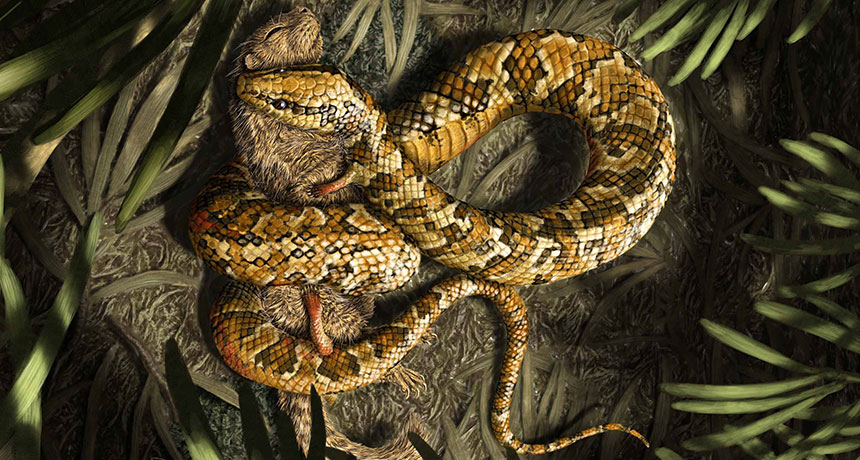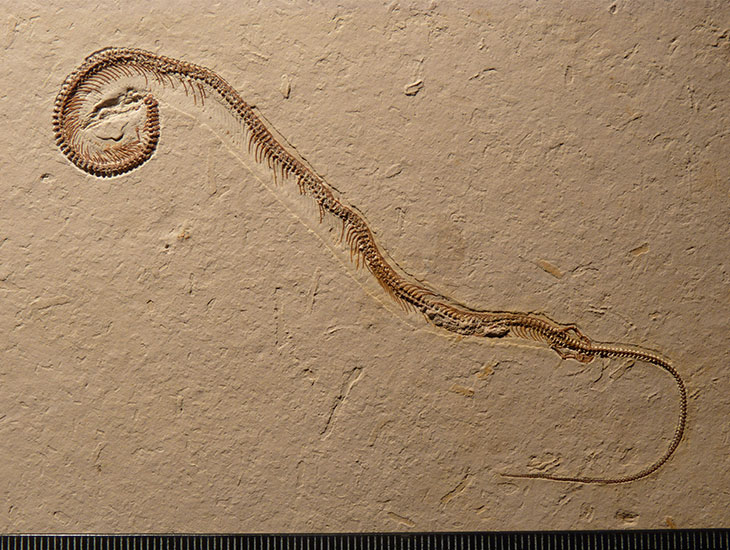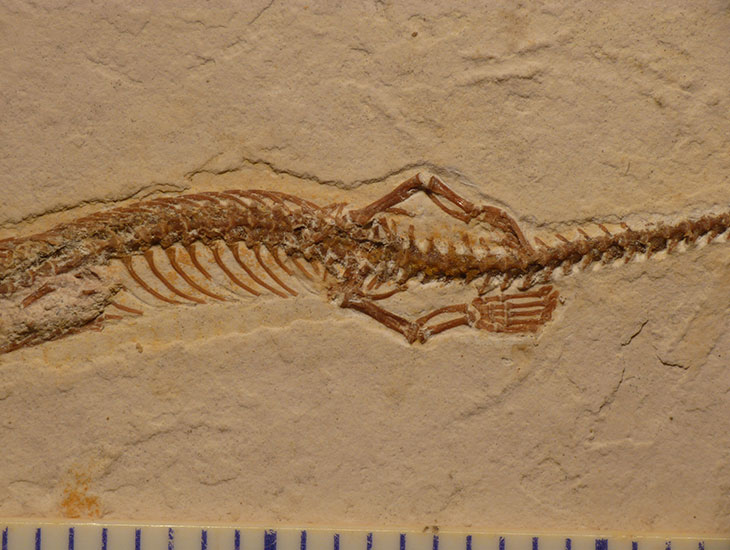Museum fossil links snakes to lizards
Four-legged specimen suggests serpents evolved first on land

MISSING LINK A fossil of a four-legged snake (shown in this illustration) offers evidence that snakes evolved from lizards.
Julius T. Cstonyi
The worldwide hunt for a fossil link between snakes and lizards has succeeded — in a museum.
The fossil, of a four-legged snake, hints that the ancestors of modern-day snakes may have evolved on land rather than at sea, researchers report in the July 24 Science. It’s the first four-legged snake fossil ever discovered, bridging the gap between snakes and lizards, says paleontologist Michael Lee of the South Australian Museum and the University of Adelaide.
“It’s a tremendously important fossil, because it’s the classic missing link,” he says. “It’s got a snakelike body but four little lizardlike legs.”
Not everyone is convinced.
“Finding the first example of a four-legged snake would be very exciting,” says Michael Caldwell, a paleontologist at the University of Alberta in Canada. “But I just don’t think this is a snake.”
Because the fossil record of early snakes is sparse, their ancient history is a little fuzzy. Some scientists think that modern snakes evolved from marine reptiles; others believe that snakes started out on land as burrowing lizards. Fossil evidence that snakes evolved from four-legged lizards is limited. A few snake fossils have nubby hind legs, but until now no one had found a fossil that so clearly connects snakes and lizards, Lee says.
The new fossil had been hiding in plain sight. Paleobiologist David Martill of the University of Portsmouth in England discovered the specimen three years ago while touring a museum in Germany. After seeing the snake (labeled “unknown fossil”), “my jaw just dropped to the floor,” he says. “I thought, ‘Bloody hell, it’s got legs!’ I was absolutely gobsmacked.”
The roughly 120-million-year-old fossil rests in a bed of fine-grained limestone. Translucent orange-brown bones coil around a squashed skull, and a lanky body stretches into a short, curving tail. Stubby hind legs with slender fingers protrude from the tail’s base, and tucked just behind the head lay two dainty forelimbs. Inside the snake’s belly, Martill found remnants of a Cretaceous snack: the bones of a frog, perhaps, he says.
The snake may have squeezed the animal to death, says study coauthor Nicholas Longrich of the University of Bath in England. It has the slinky, coiling spine of a constrictor, he says, with legs that potentially helped it grip prey.
Martill believes the snake, named Tetrapodophis amplectus, lived on land because it was found with other fossilized land-dwellers, such as spiders and scorpions. And comparing the specimen’s skeleton with those of hundreds of other animals convinced the team that their four-legged fossil actually was once a snake.
“There’s no doubt that this thing is a snake,” Longrich says. “It’s got snake scales, snake vertebrae, snake jaws, snake teeth and little bones in its belly where it swallowed an animal whole.”
Caldwell disagrees. The fossil’s head is too crushed to draw any conclusions, he says. Plus, the skeleton is missing key snakelike bony bits on the vertebrae. Earlier this year, Caldwell reported the discovery of even older snake fossils (SN: 2/21/15, p. 11) and suggested that they might have had four legs. But those specimens, mostly fragmentary skulls and teeth, were in much worse shape than the current find.
Caldwell acknowledges that he might be wrong about the new fossil. He and other scientists agree that they’d like to examine it more closely.
Vertebrate paleontologist Jacques Gauthier of the Yale Peabody Museum of Natural History thinks a 3-D scan of the fossil would help researchers get a better look. Even without it, though, he says, “I have to say, I do think it is a snake.”









